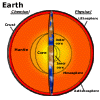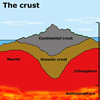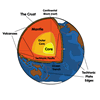The rocks, soil and water on the surface of the Earth make up only a tiny fraction of the total mass and volume of the Earth. Centuries ago, people used to think that the Earth was flat, or even a hollow sphere. Today, by monitoring vibrations in the Earth caused by earthquakes, and examining the rock erupted out by volcanoes, we know that the Earth has a complex layered structure. This topic investigates the internal structure of the Earth.
The layered Earth
The Earth can be divided up into sections or layers according to two criteria
- chemical composition and physical properties. There are three chemical
layers; the crust, the mantle and core and five recognised physical layers;
the lithosphere, asthenosphere, mesosphere, outer core and inner core.
Chemical layers
Chemically, the Earth is divided into three layers.
- The outer most layer, the crust, consists nearly entirely of rocky
silicate material, with some aluminium and trace amounts of all the
naturally occurring elements. It can be up to 50km thick, but in places
is as thin as 5km. Considering the Earth has a radius of some 6400km,
the crust is like a very thin eggshell.

There are two types of crust, continental crust and oceanic crust. The denser oceanic crust surrounds the whole Earth, with "islands" of less dense continental crust floating in it. The continents are made of continental crust, while the ocean floors and below the continental crust are oceanic crust.
- The next layer is the mantle. The mantle extends from the crust 2900km
down and is composed of silicates with large amounts of iron and magnesium.
- The third layer, the core, extends a further 3400km to the centre of the Earth. The core is primarily made of iron and nickel metals and is very hot - from 3200°C to 4000°C. It is the magnetic iron and nickel in the core that is thought to be responsible for the Earth's magnetic field.
Physical layers
As already mentioned, the temperature within the Earth increases the deeper
you go, reaching 4000°C at the centre. Pressure also increases dramatically
with depth. The combination of these two factors creates five distinct
layers or regions within the Earth alternating between solid, liquid and
semi-liquid or "plastic" phases.
The outermost physical layer is the lithosphere (LITH uhs feer). Thin, cool and solid, the lithosphere contains the crust and some of the mantle. Composed mainly of silicates, it "floats" on the underlying asthenosphere.
The asthenosphere (as THEHN uhs feer) is hotter and in a semi-liquid state. Starting at around 80 to 100 km deep, the rock in the asthenosphere slowly flows in a plastic state moving in a circular motion creating convection currents of hot rock. This moves heat from deep within the mantle towards the surface. It is this movement which helps move the continents and creates volcanoes and lava flows.
Next is the mesosphere. Comprising the inner part of the mantle, the mesosphere is a region of very hot solid rock. Here, although hotter than the asthenosphere, the pressure is too high for liquid rock to form.
The core is divided into two parts, the liquid outer core, where temperature wins over pressure and the solid inner core where again the pressure is too high for a liquid to form.
 Moving
in from the surface to the centre of the Earth you could expect to getter
hotter and be subjected to ever increasing pressure, but you would go
from solid, through flowing semi-liquid plastic rock to solid, liquid
and finally solid again at the centre.
Moving
in from the surface to the centre of the Earth you could expect to getter
hotter and be subjected to ever increasing pressure, but you would go
from solid, through flowing semi-liquid plastic rock to solid, liquid
and finally solid again at the centre.
A quite different journey to Jules Vernes' "Journey to the centre
of the Earth".
| Copyright owned by the State of Victoria (Department of Education and Early Childhood Development). Used with Permission. |

